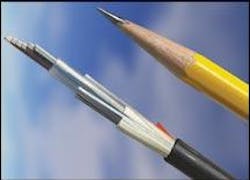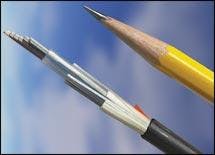Next-generation fiber installation: Air-blown optimized cables
European operators already understand the benefits of air-blown technology; now American carriers are taking a closer look.
JASON PEDDER, ELMAR STAUDINGER, HAROLD DEBBAN, and MARIO ROSSI, OFS
Service providers need solutions that can meet the pressures of today's rapidly changing, increasingly competitive telecommunications market. Fiber-optic cable plays an important role in achieving a sustainable competitive advantage.Although, the incumbent operators-RBOCs and PTTs-are no longer the exclusive operators of the optical-network infrastructures, they still own the majority of network ducts, which arms the incumbents with a considerable competitive edge and poses a barrier of entry to multiservice operators and competitive local-exchange carriers. The percentage of users connected directly to telecom networks via fiber is still very small worldwide. In the United States, fiber-to-the-home (FTTH) systems are projected to increase from 89,000 homes in 2001 to 2.65 million homes by 2006, according to market researcher KMI (Providence). As a result, the FTTH equipment market is expected to grow from an estimated $100 million last year to nearly $1 billion in 2006. Despite the difficulty of forecasting this marketplace, fiber-to-the-x (FTTx) represents a considerable business opportunity-access to new customers is an invaluable asset. Even utility companies have started to envision using their gas, water, and sewer networks to provide this access.
The most difficult part of provisioning fiber into a network is the cable installation. There are many different installation methods available, depending on the local conditions and infrastructure. An increasingly popular method is the air-blown technique, used widely in European countries for several years. It allows for fast, safe, and relatively inexpensive cable deployment. To maximize the advantage of this technology, the cables must comply with specific requisites, including lightweight structure, balanced flexibility, limited diameter, and sheath design.
Preparing the cable path
One air-blown installation option consists of pulling, or blowing, sub-ducts inside a duct and then blowing small cables inside these sub-ducts. The sub-ducts allow for installing cables in incremental phases as required. Instead of installing a high-fiber-count cable, the network operator deploys only the fiber needed, then installs more cables as required. This solution provides a lower initial investment and the flexibility to deploy and upgrade to the latest fiber technologies after the initial installation. The network operator's total investment could, however, end up higher than deploying a single high-fiber-count cable. The actual costs depend on several variables like interest rates, the cost of multiple installations per route, and the cost of the sub-ducts. The best option requires careful analysis of several variables:
- Network topology.
- Demographics-where are the potential customers? How many are there? What are the concentration areas and the projected growth rates?
- Network deployment projection rate-if projections indicate fast growth, a high-fiber-count cable may be a better option.
- Plant and installation costs-the service provider needs to evaluate all options for reaching potential customers. A combination of options (e.g., ducts and aerial drops, or ducts and sewer lines) may offer the most economical and quick deployment solution. Rights-of-way play a fundamental role in this analysis.
- Cost of money-includes considerations such as net current value and interest rates.
Relatively new players in the telecom market, utility companies require exceptionally small-diameter cables. It is common to use sewer, water, and gas pipes as conduits for the optical cables where the cables can be installed inside conduits in the pipes or directly in the pipes. The smaller the cable/conduit diameter, the better, since it will cause less flow interference in the pipe.
The Figure illustrates sub-ducts, or micro-ducts, installed in a standard duct. A 1.25-inch (32-mm) duct allows up to five 3/8-inch (10-mm) sub-ducts. Using a 7/32-inch (5.9-mm)-diameter, 48-fiber cable in each sub-duct, permits up to 240 fibers in this duct. A 72-fiber cable would allow for 360 fibers in the same duct, less than an 864-fiber standard cable would allow installed in this size duct. However, the 864-fiber standard cable would require a higher initial investment-the service provider could not defer costs.
Specialty cableGone are the days when cables simply had to protect fibers from environmental agents and installation stress. Today, activating a customer and keeping that link up is critical, especially when service providers face fierce competition and must adhere to strict service-level agreements. As the latest-generation cables enter the specialty arena, this technology may provide a competitive edge for service providers-the same way fibers did with application-specific fibers.The air-blown technique consists of pumping compressed air into a duct to form an air stream. This stream has an aerodynamic effect, keeping the cable floating and pulling it through the duct. A small mechanism at the entrance of the duct controls the cable's speed. This relatively simple process allows for fast cable installation, less mechanical stress on the cable, and fewer technicians, resulting in lower installation costs. Air-blown optimized cable can support speeds higher than 200 ft (about 60 m) and reach spans of 6,500 ft (~2,000 m) from a single blowing point; the speed and span are dependent on the installation route, duct size, and equipment.
To optimize the air-blowing process, several characteristics enable the cable to float in the air stream through the ducts:
- Weight. Makes it easier for the air stream to carry the cable through the ducts.
- Balanced flexibility. If the cable is too rigid, it won't deploy easily in curves, which are very common in metropolitan duct networks. Too much flexibility, however, would result in the fiber cable having more contact with the tube or duct walls, which can increase friction, reduce installation length, and result in insufficient fiber protection.
- Small diameter. The smaller the diameter, the more versatile the cable is, which is important in the metro environment, because any available space is a potential cable path.
- Sheath profiling. Consists of creating special sheath designs that help the air lift and push the cable through the ducts.
- Cable construction. Diverse environments require adaptable cables. For example, with gas pipes, an all-dielectric construction is preferred for safety reasons.
Combining all these features together effectively is not an easy task and demands considerable experience and knowledge from the cable designer.
Installation advantages
In addition to installing a cable faster, the air-blowing method subjects the cable to fewer mechanical stresses. The traditional pulling method requires the use of pulleys and tension control equipment. Inadequately trained crews may not operate the equipment appropriately and can compromise cable sections, which in turn may affect a cable's longevity, fiber operations, and reliability. The air-blowing method distributes the tensions along the sheath and thus is unlikely to cause any cable damage. Air-blown optimized cables are not subjected to the same installation loads as standard cables and therefore can be lighter and more flexible. A cable optimized for air-blowing can contain 48 fibers in less than a 6-mm diameter (1.8 fibers/mm2) using ribbon fibers or 300 fibers in just a 15-mm diameter (1.7 fibers/mm2) with loose-tube technology.
Less weight and smaller size also are advantages for transporting, handling, and packaging air-blown optimized cables. The small size of the air-blown cable and its use of sub-ducts likewise are advantages in a marketplace where it is extremely difficult to forecast demand but is imperative to provide access immediately.
Low-cost, flexible solution
Service providers are exploring several alternatives to bring fiber closer and closer to end users as demand for more bandwidth increases. The metro area still lacks optical connections between service providers and potential customers who are demanding more bandwidth. Current economic conditions have delayed FTTx projects, but the demand is there. Air-blown optimized cables represent a cost-effective and very flexible solution for this challenge.
European service providers have a lot of experience with air-blowing cables and consider this installation method reliable and cost-effective. That has not gone unnoticed by American service providers, many of which have begun investigating this technology's benefits.
Jason Pedder is manager of development projects and Elmar Staudinger is product-line manager, Europe, Middle East, and Africa, at OFS Germany in Augsburg; Harold Debban is a distinguished member of the technical staff, optical-cable development, at OFS Labs (Norcross, GA); and Mario Rossi is an optical-cable applications manager at OFS USA (Norcross).



